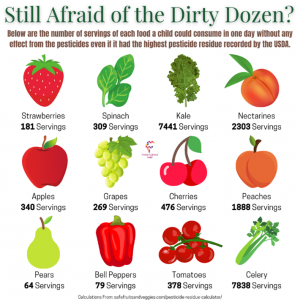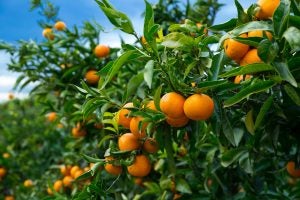It’s that time of year again for the annual “Dirty Dozen” and “Clean Fifteen” lists from the Environmental Working Group (EWG). The EWG publishes these lists on their website every spring, and without scrutiny or context, the lists get picked up by major media outlets such as CNN and local news in cities like Philadelphia and St. Louis. The EWG claims to be ranking fruits and vegetables based on the levels of pesticides from “dirtiest” to “cleanest,” but is that really the case? Do we really need to worry about “dirty” food? Are there “toxic pesticides” on our foods as the EWG wants you to believe? Well, not exactly. The phrase “toxic pesticides” in and of itself is a nonsense term. ‘The dose makes the toxin’ applies to all pesticides, even the ones used in organic farming, and despite what the EWG may lead you to believe, organic farming uses pesticides, too.
While the EWG may seem like an unbiased, legitimate organization, once you start to do a little digging you can see that they are largely funded by the organic industry with ties to the likes of Organic Valley, Stonyfield Farms and Earthbound Farms, just to name a few. Their board members include one of most well-known charlatans, Dr. Mark Hyman, who sells dietary supplements and detox products. So, if you think that they are simply an unbiased organization that does what’s best for consumers, that couldn’t be further from the truth.
» Last year: The tone-deaf decision to publish the ‘Dirty Dozen’ despite global pandemic
Here’s the real dirt on how the Dirty Dozen comes to be.
Every year scientists from the U.S. Department of Agriculture visit commercial food channels and collect more than 10,000 food samples. The Pesticide Data Program (PDP) manages the sampling, testing and reporting of pesticide residues on a wide variety of domestic and imported foods using a sound statistical program. The pesticide data that the USDA publishes each year provide regulators, scientists, registrants, farmers, processors, and consumers with important insights into the actual levels of pesticide residues found on widely consumed foods. The Environmental Protection Agency uses PDP data to conduct dietary risk assessments and to ensure that any pesticide residues in foods remain at safe levels. This data shows us year after year how incredibly safe our food is from a pesticide residue perspective. In 2019, over 99 percent of the samples tested had residues well below the tolerances established by the EPA, with 42 percent having no detectable pesticide residue at all. In fact, the residues are so incredibly low (parts per BILLION levels) that we’d essentially have to eat a toxic level of any of these foods before even reaching a level in which the pesticide residues may have negative effects.
The Alliance for Food and Farming put together a calculator that shows just how many servings of each of the foods included on EWG’s Dirty Dozen a man, woman, teen or child would have to consume before reaching the No Adverse Effects Level (NOAEL) of pesticides based on the highest pesticide residue recorded for that food by the USDA. Here are the results for the foods listed on the 2021 “Dirty Dozen” based on how many servings a child would have to consume to reach the NOAEL:

Despite this data consistently showing how safe our food is, the EWG manipulates this very data to scare consumers about perfectly safe conventional foods. They publish their list every spring and recommend that people purchase organic versions of these fruits and vegetables because they claim that they are “cleaner” and have less pesticide residues. However, what they do in their “analysis” is take the USDA PDP data and just count the number of pesticide residues on each type of food. That’s it. The list is made up based on the total number of different pesticides detected on each food. They completely disregard what the chemical is, at what concentration it occurs on the food and how that compares to the crop-chemical-specific EPA tolerance levels.
This is not a risk assessment. The EWG even states on its website, “The Shopper’s Guide does not incorporate risk assessment into the calculations. All pesticides are weighted equally, and we do not factor in the levels deemed acceptable by the EPA.” They also don’t ever mention that fact that organic farming uses pesticides, too, and that the organic versions of these foods will have pesticide residues as well. In addition to that, they leave out the fact that the USDA PDP is not set up to be able to detect most of the organic-approved pesticides because it would require expensive and specific assays. Only the organic-approved fermentation product, Spinosad, is detected by the methods used.
Thus, the PDP does not show us a complete picture, however, it does show us that our produce supply is very safe from a pesticide residue perspective.
This year, the EWG specifically singled out fungicides used in citrus fruits and are attempting to scare consumers by claiming that they are hormone-disrupting and cancer-causing based on rodent studies administered at very high doses. Once again, the dose makes the poison. The largest average detection that the EWG found for a fungicide called imazalil was 174 parts per billion (ppb) on mandarins. Based on the Acceptable Daily Intake (ADI) of 0.03 mg per kg of body weight per day, a 30 kg child would have to consume over 57 average size (90 g) mandarin oranges per day to reach the ADI, or over 4,000 per day to reach the No Observable Adverse Effects Level (NOAEL). Similar calculations would follow for the other fungicide they singled out, thiabendazole, based on a similar detection of an average of 128 ppb on mandarins and a chronic reference dose (RfD) of 0.033 mg per kg bodyweight per day. A 30 kg child would have to consume over 85 average size (90 g) mandarin oranges per day to reach the ADI or over 26,000 per day to reach the No Observable Adverse Effects Level (NOAEL).
It’s incredibly disingenuous for the Environmental Working Group to be scaring consumers over these numbers.

Furthermore, the EWG manipulated this data in order to conclude that just one serving would be over the safety level that they arbitrarily set. This is downright deceptive. For their imazalil calculations, they took the already conservatively set ADI of 0.03 mg per kg body weight per day and arbitrarily reduced it even further so that they could then state that a 140 g serving of citrus was well over their safety levels. This is so incredibly dishonest. The ADI for a 30 kg child would be 900 micrograms per day based on the ADI of 0.03 mg per kg body weight per day. The EWG set their allowable daily limit of imazalil exposure to be 0.7 micrograms per day. This makes entirely no scientific sense. They know the average consumer isn’t going to read through and understand their methodology section to see what they’ve done. It’s so sneaky and deceptive.
This is the case year after year. The PDP annual summaries consistently show that 99 percent of sampled products have residues well below EPA tolerances, which are set based on an extensive and rigorous risk assessment reflecting all the toxicological information available. The EWG then takes that data and ranks the foods based on a metric that has absolutely nothing to do with the safety of the food. Year after year the data also shows that a small number of synthetic pesticide residues not allowed in organic farming are detected on most organic crops as shown in this analysis by Ph.D. Plant Pathologist Steven Savage.
The other shocking part is that there is an allowance in the USDA’s National Organic Program rules stating that if a synthetic pesticide residue is detected on an organic product, if the level is 5 percent or less of the EPA tolerance, it is considered “unintentional” and thus not a violation of the organic certification standard. In this analysis of the 2017 PDP data by Savage, he shows that 99.2 percent of the organic samples from the U.S. and 98.4 percent of the organic imports would have met the 5 percent or less standard. What is so shocking and goes against the EWG’s narrative is that 96.3 percent of the conventional samples from the U.S. and 94.1 percent of the imported conventional samples would also “qualify” if they had been organic samples being tested for compliance. Year after year the PDP data demonstrate that pesticide residues found on foods tested are detected at levels well below the EPA tolerances and pose no safety concern. Consumers should feel confident about eating a diet that is rich in fresh fruits and vegetables.
This isn’t just benign misinformation either. It can cause some real harm. A recent study showed that fear-based messaging regarding pesticide residues resulted in low-income consumers stating they were less like to purchase any produce — organic or conventional.
“EWG continues to dismiss the needs of consumers and disrespects farmers by choosing to inaccurately disparage the very foods health experts agree we should eat more of every day to improve immune function, prevent diseases and increase lifespan,” says Teresa Thorne, Executive Director of the Alliance for Food and Farming. “With only one in 10 Americans eating enough fruits and vegetables each day, we should be promoting consumption to enhance immune function and prevent illness, not discouraging it with tactics like the ‘dirty dozen’ list,” Thorne adds.
I think it’s time that the EWG really needs to reflect on the harm they are causing. Fear sells, and they’re making a lot of money from it, so we can’t expect them to change. However, we as consumers can change, and we can stop letting deceptive, biased, and completely non-evidence based organizations determine our purchasing behavior.
For more information, please watch the IG Live Q&A I did with Tamika Sims, Ph.D., from the International Food Information Council:
Food Science Babe is the pseudonym of an agvocate and writer who focuses specifically on the science behind our food. She has a degree in chemical engineering and has worked in the food industry for more than decade, both in the conventional and in the natural/organic sectors.



